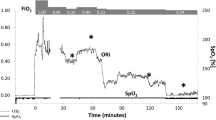Abstract
Current hypoxic guards systems fail to maintain the inspired O2 concentration (FIO2) ≥ 21 % across the entire fresh gas flow (FGF) range when a second carrier gas is used (N2O or air). We examined the performance of the Maquet O2 Guard®, a smart hypoxic guard that increases O2 delivery if an inspired hypoxic mixture is formed. After obtaining IRB approval and informed consent, 12 ASA I-II patients were enrolled. During anesthesia with sevoflurane in O2/air, the O2 Guard® was tested by administering O2/air at the following delivered hypoxic guard limits [expressed as (total FGF in L min−1; FDO2 in %)] for 4 min each: [0.3;67], [0.4;50], [0.6;34], [0.8;25], [1.0;21], [1.2;21], [1.5;21], [2;21], [3;21], and [5;21]. The following data were collected: (1) time from FIO2 = 30 to 20 %; (2) time from FIO2 = 20 % to O2 Guard® activation; (3) time from O2 Guard® activation to FIO2 = 25 %; (4) FGF and FDO2 used by the O2 Guard. If SpO2 was <90 % for 10 s or longer at any time, the patient was excluded. Three patients were excluded for low SpO2. The incidence of FIO2 < 21 % was 100 % within the 1–2 L min−1 FGF range. The O2 Guard® was activated within 20 s after FIO2 became 20 %, except in one patient where FIO2 oscillated between 20 and 21 %. FDO2 was increased to 60 % and FGF to 1 L min−1 (the latter only if it was lower than 1 L min−1 prior to activation of the O2 Guard). FIO2 increased to 25 % within 55 s after O2 Guard activation in all patients. The O2 Guard®, an active inspired hypoxic guard, rapidly reverses and limits the duration of inspired hypoxic episodes when the delivered hypoxic guard fails to do so.







Similar content being viewed by others
References
Dorsch JA, Dorsch SE. Understanding anesthesia equipment. 5th ed. Philadelphia: Lippincott Williams & Wilkins; 2007. p. 108–10.
ASTM (American Society for Testing and Materials) Standard F1850-00, clause 51.13.1 Protection Against Accidental Delivery of Hypoxic Gas Mixtures.
International Organization for Standardization (ISO) and the International Electrotechnical Commission (IEC) Standard EN60601-2-13, clause 51.102.2 Anaesthetic gas delivery system.
De Cooman S, Schollaert C, Hendrickx JF, Peyton PJ, Van Zundert T, De Wolf AM. Hypoxic guard systems do not prevent rapid hypoxic inspired mixture formation. J Clin Monit Comput. 2014 Oct 1, published ahead of print.
User’s Manual FLOW-i 4.0 Anesthesia System, Infologic 1.58. Maquet Getinge group, p. 66–7.
Conflict of interest
The authors declare that they have no conflict of interest, but Jan Hendrickx received lecture support, travel reimbursements, equipment loans, consulting fees and/or meeting organizational support from a number of companies involved with inhaled agent delivery (alphabetically): AbbVie, Acertys, Air Liquide, Allied healthcare, Armstrong Medical, Baxter, Draeger, GE, Hospithera, Heinen und Lowensein, Intersurgical, Maquet, MDMS, MEDEC, Micropore. Molecular, NWS, Philips, Quantum Medical. The FLOW-i tested in this study has been provided by Maquet on a temporary basis.
Author information
Authors and Affiliations
Corresponding author
Additional information
Jan Hendrickx, Sofie De Cooman, Rik Carette, Philip Peyton, and Andre De Wolf are members of the NAVAt group.
Electronic supplementary material
Below is the link to the electronic supplementary material.
Supplementary material 1 (MPG 135950 kb)
Rights and permissions
About this article
Cite this article
Ghijselings, I.E., De Cooman, S., Carette, R. et al. Performance of an active inspired hypoxic guard. J Clin Monit Comput 30, 63–68 (2016). https://doi.org/10.1007/s10877-015-9684-9
Received:
Accepted:
Published:
Issue Date:
DOI: https://doi.org/10.1007/s10877-015-9684-9




